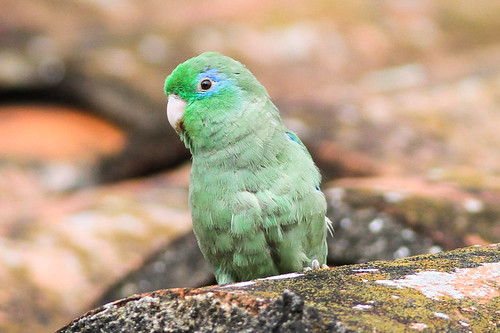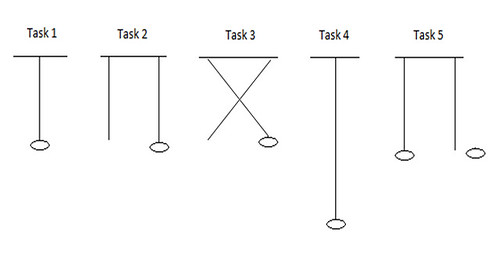Problem-Solving Parrots Understand Cause and Effect
 Thursday, October 17, 2013 at 12:09
Thursday, October 17, 2013 at 12:09  Spectacled Parrotlet (Forpus conspicillatus). Image by Ron KnightScientists speculate two factors may influence why some animal species are smarter than others: the foraging behavior of a species (for instance, how cognitively demanding it is for the animals to obtain food) and the social complexity of the animals’ society.
Spectacled Parrotlet (Forpus conspicillatus). Image by Ron KnightScientists speculate two factors may influence why some animal species are smarter than others: the foraging behavior of a species (for instance, how cognitively demanding it is for the animals to obtain food) and the social complexity of the animals’ society.
A new study looked at problem-solving skills, which reflect animals’ ability to understand and solve a novel situation, and whether they’re related to a species’ social complexity or foraging ecology. Anastasia Krasheninnikova, Stefan Bräger, and Ralf Wanker of the University of Hamburg, Germany, tested four parrot species with different social systems and diets: spectacled parrotlets, green-winged macaws, sulphur-crested cockatoos, and rainbow lorikeets.
 Research design. Krashenninikova et al., (2013)“One of the characteristics of complex cognition in animals is the ability to understand causal relationships spontaneously, and one way of testing this is asking the animal to obtain a reward that is out of reach,” says Krasheninnikova. She and her colleagues gave the birds five variations on a string-pulling task, involving strings that varied in their relationship to each other or to a food reward, to see whether the birds really understood the means-end relationship between the string and the food.
Research design. Krashenninikova et al., (2013)“One of the characteristics of complex cognition in animals is the ability to understand causal relationships spontaneously, and one way of testing this is asking the animal to obtain a reward that is out of reach,” says Krasheninnikova. She and her colleagues gave the birds five variations on a string-pulling task, involving strings that varied in their relationship to each other or to a food reward, to see whether the birds really understood the means-end relationship between the string and the food.
The first test was a basic string-pulling task in which the bird must figure out how to pull up a piece of food suspended from a perch by a single piece of string. Almost all the birds of all species solved this test immediately.
In the second task, there were two hanging strings, but only one was attached to a piece of food. If the bird really understood the string as a means to obtain the reward, it should pull only the rewarded string. Most of the birds (more than 75%) were able to solve this test on their first try.
To make sure that the bird really understood the functional relationship between food and string and was not just pulling the string closest to the food reward, the third task used a pair of crossed strings. In this test, pulling the string directly above the food would not result in obtaining the food, while pulling the further string that is actually attached to the food would. The spectacled parrotlets and rainbow lorikeets outperformed the macaws and cockatoos on this test, and only the parrotlets were able to figure out the test when the strings were the same color. Krasheninnikova says this study is the first to document a parrot species solving the crossed-strings task spontaneously.
The fourth task probed the flexibility of the bird’s behavior. The string was longer, so the bird could obtain the food from the ground rather than pulling the string up. Several members of all species adapted their problem-solving strategies by stopping string-pulling behavior and obtaining the food from the ground, but only the parrotlets and lorikeets clearly preferred the alternative strategy.
In the fifth and final task, there were two rewarded strings, but one had a gap between its end and the reward. Solving this task required the bird to understand the mere presence of the reward does not guarantee the reward can be obtained; the food had to be connected to the string to work properly. Parrotlets were the only species to successfully solve task five.
When Krasheninnikova and her colleagues compared their results to the birds’ lifestyles, they found the pattern in performance was best explained by differences in the species’ social structures rather than their diets.
Spectacled parrotlets performed best of the four species tested and they live in what’s known as a fission-fusion society. These birds live in large groups where they form different social subunits that split and merge, providing the opportunity for many different kinds of social interactions. They are also the only one of the four species tested to form crèches where young birds pass through the socialization process.
Green-winged macaws and sulphur-crested cockatoos live in small, stable family groups centered around a breeding pair and their offspring. These species failed tests four and five.
 Rainbow lorikeet amongst the Golden Penda (Xanthostemon chrysanthus). Image by Tatiana GerusThe social organization of rainbow lorikeets falls somewhere between the parrotlets and the macaws and cockatoos — as does their performance on the string-pulling tasks. Lorikeets live in social groups of 10-40 individuals, but do not form subunits such as crèches. They performed better than macaws and cockatoos, but not as well as parrotlets.
Rainbow lorikeet amongst the Golden Penda (Xanthostemon chrysanthus). Image by Tatiana GerusThe social organization of rainbow lorikeets falls somewhere between the parrotlets and the macaws and cockatoos — as does their performance on the string-pulling tasks. Lorikeets live in social groups of 10-40 individuals, but do not form subunits such as crèches. They performed better than macaws and cockatoos, but not as well as parrotlets.
While these results support the social complexity hypothesis, the correlation between social structure and cognitive performance is mostly indirect. The reasoning behind the hypothesis is that living in social groups is cognitively demanding. “Individuals have to recognize group members and infer relationships among them,” Krasheninnikova says. “These demands favor the evolution of understanding functional relationships, such as which actions cause which outcomes.” Socially living animals might be able to apply this cause and effect thinking to their physical world as well as their social lives.
Reference:
Krasheninnikova, A., Bräger, S., and Wanker, R. (2013). Means-end comprehension in four parrot species: explained by social complexity. Animal Cognition 16(5): 755-764. doi: 10.1007/s10071-013-0609-z

